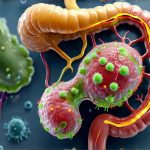Our digestive systems are remarkable ecosystems, housing trillions of microorganisms – bacteria, fungi, viruses, and more – collectively known as the gut microbiota. This complex community isn’t just passively residing within us; it’s actively involved in nearly every aspect of our health, from digestion and nutrient absorption to immune function and even mental wellbeing. Increasingly, research highlights that a diverse and robust gut microbiome is key to overall health, acting as a first line of defense against illness and contributing significantly to long-term vitality. However, modern lifestyles – characterized by processed foods, stress, antibiotic overuse, and reduced exposure to natural environments – often disrupt this delicate balance, leading to what’s commonly referred to as “gut dysbiosis,” where the harmful bacteria outweigh the beneficial ones.
Building gut resilience isn’t about eliminating all potential threats or chasing a ‘perfect’ microbiome; it’s about fostering an environment within that supports a thriving ecosystem. It’s a proactive approach, focusing on nourishing our microbial communities with what they need to flourish – primarily through the food we eat. This means prioritizing nutrient-dense, whole foods, particularly those rich in plant fiber and phytonutrients, while simultaneously minimizing inflammatory triggers. The goal is to cultivate a gut that can adapt and recover quickly from inevitable stressors, maintaining its functionality and contributing to a strong foundation of health. How to balance gut acidity is also crucial for overall function.
The Power of Plant Diversity
The cornerstone of gut resilience lies in dietary diversity – specifically, the wide range of plant foods we consume. Our gut microbes thrive on variety; each different species benefits from unique compounds found in various fruits, vegetables, legumes, whole grains, nuts, and seeds. Think of it like a garden: if you only plant one type of flower, it’s vulnerable to specific pests and diseases. A diverse garden is much more resilient because it contains a wider range of defenses and can withstand environmental changes better. – This principle applies directly to our gut microbiome.
A diet lacking in plant diversity leads to a less robust microbial community. When we repeatedly feed the same microbes, others starve and diminish, resulting in a loss of overall functionality and potentially creating space for opportunistic pathogens. Research has shown that individuals who consume 30 different plant-based foods per week tend to have significantly more diverse gut microbiomes compared to those with limited dietary variety. This isn’t about complicated recipes or restrictive diets; it’s simply about incorporating a wider spectrum of colors, textures, and flavors into your meals. Building gut-friendly bowls can be an easy way to incorporate more plant diversity into your diet.
Beyond the sheer number of plants, phytonutrients play a crucial role. These naturally occurring compounds found in plant foods offer various health benefits, but crucially, they also serve as food for our gut microbes. Different phytonutrients feed different microbial species, further promoting diversity. Polyphenols, found abundantly in berries, dark chocolate, and green tea, are particularly beneficial for fostering a healthy gut environment. Focusing on incorporating a rainbow of produce into your diet is an excellent strategy for maximizing phytonutrient intake and supporting a thriving microbiome.
Low-Inflammatory Eating: Calming the Gut Environment
Chronic inflammation is a major disruptor of gut health. When our bodies are constantly in a state of inflammation, it can damage the gut lining, compromise its barrier function (often referred to as “leaky gut”), and negatively impact microbial diversity. Dietary choices significantly influence the inflammatory status of our bodies. – Highly processed foods, sugary drinks, refined carbohydrates, and excessive amounts of saturated and trans fats are known pro-inflammatory triggers.
A low-inflammatory diet focuses on minimizing these triggers while prioritizing anti-inflammatory foods. This isn’t about eliminating entire food groups but rather making mindful choices that support a calmer gut environment. Omega-3 fatty acids, found in fatty fish (salmon, mackerel, sardines), flaxseeds, chia seeds, and walnuts, are powerful anti-inflammatory agents. Similarly, spices like turmeric, ginger, and cinnamon contain compounds with potent anti-inflammatory properties.
Furthermore, identifying and addressing food sensitivities can be a crucial step towards reducing gut inflammation. While food allergies involve an immune response, food sensitivities often manifest as subtle digestive symptoms or systemic issues without triggering a full-blown allergic reaction. Keeping a food journal to track how different foods affect your body can help identify potential triggers. Remember, what causes inflammation varies from person to person; there’s no one-size-fits-all approach. If you’ve recently experienced stomach infections, rebuilding gut resilience is especially important.
Fermented Foods: Introducing Beneficial Microbes
Fermented foods are essentially pre-digested by beneficial bacteria and yeasts, making them incredibly easy for our bodies to absorb nutrients from. They also contain probiotics, live microorganisms that can colonize the gut (though their effects vary depending on the individual and the specific food). – Incorporating fermented foods into your diet is a simple way to introduce beneficial microbes and support gut diversity.
Examples of fantastic fermented foods include:
* Yogurt (choose plain, unsweetened varieties with live cultures)
* Kefir
* Sauerkraut (unpasteurized)
* Kimchi
* Kombucha
* Miso
* Tempeh
It’s important to note that the probiotic content can vary significantly between different brands and preparations. Start slowly with small portions to assess your tolerance, as some individuals may experience temporary digestive discomfort when first introducing fermented foods into their diet. Over time, regular consumption can help foster a more balanced and resilient gut microbiome. Combining warm liquids alongside these foods may also ease digestion for some.
Fiber’s Role in Gut Resilience
Fiber is the indigestible part of plant foods that acts as the primary food source for our gut microbes. It’s not just about “roughage”; different types of fiber support different microbial communities, further enhancing diversity. – There are two main types of fiber: soluble and insoluble. Soluble fiber dissolves in water and forms a gel-like substance, which helps regulate blood sugar levels and lower cholesterol. Insoluble fiber adds bulk to stool and promotes regularity.
Many plant foods contain both types of fiber, but prioritizing a wide range of sources is key. Legumes (beans, lentils, chickpeas), oats, barley, fruits, and vegetables are all excellent sources of fiber. Aim for at least 25-30 grams of fiber per day. – Gradually increase your fiber intake to avoid bloating or discomfort; drinking plenty of water is also essential to help the fiber move through your digestive system effectively. Moving too quickly after meals can negate some of these benefits, so pace yourself!
Stress Management & Gut Health: The Mind-Gut Connection
The gut and brain are intimately connected via what’s known as the “gut-brain axis.” Chronic stress can significantly impact gut health by altering microbial composition, increasing intestinal permeability (leaky gut), and suppressing immune function. Conversely, a healthy gut microbiome can influence mood, cognitive function, and emotional regulation. – Managing stress is therefore essential for building gut resilience.
Effective stress management techniques include:
* Regular exercise
* Mindfulness meditation
* Deep breathing exercises
* Spending time in nature
* Social connection
* Adequate sleep
Prioritizing self-care and incorporating stress-reducing practices into your daily routine can have a profound impact on both your mental and gut health. Remember, building gut resilience is a holistic process that encompasses not just dietary choices but also lifestyle factors that support overall wellbeing. It’s about creating an internal environment where both our bodies and our microbial communities can thrive. Building confidence in your gut through testing and understanding is also a powerful approach to long-term health. Finally, building a timeline of gut recovery can help track your progress.


















